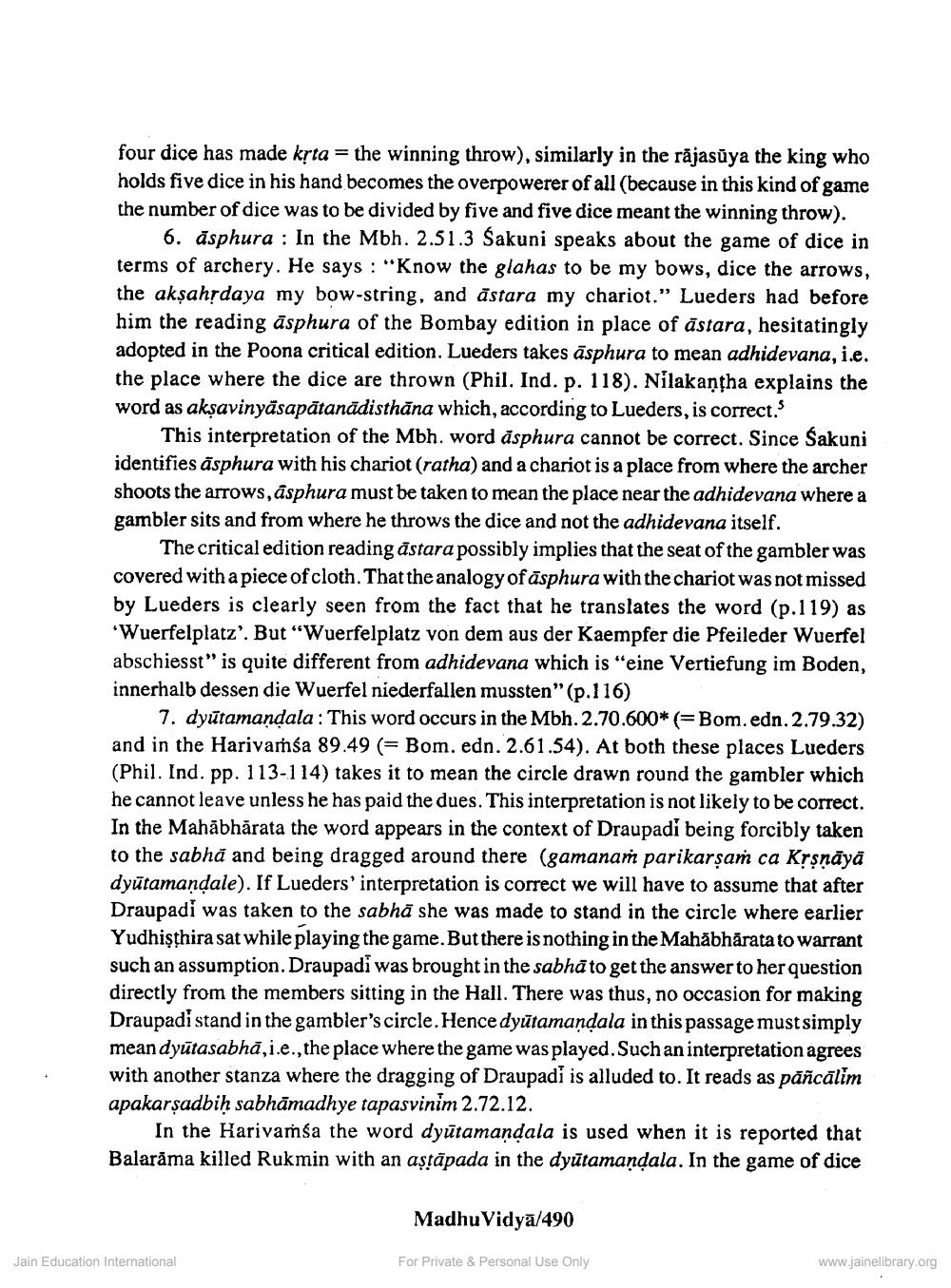________________
four dice has made krta = the winning throw), similarly in the rājasūya the king who holds five dice in his hand becomes the overpowerer of all (because in this kind of game the number of dice was to be divided by five and five dice meant the winning throw).
6. ăsphura : In the Mbh. 2.51.3 Sakuni speaks about the game of dice in terms of archery. He says : "Know the glahas to be my bows, dice the arrows, the akşahrdaya my bow-string, and ästara my chariot." Lueders had before him the reading asphura of the Bombay edition in place of ăstara, hesitatingly adopted in the Poona critical edition. Lueders takes asphura to mean adhidevana, i.e. the place where the dice are thrown (Phil. Ind. p. 118). Nilakantha explains the word as akşavinyasapātanädisthāna which, according to Lueders, is correct.
This interpretation of the Mbh. word asphura cannot be correct. Since Sakuni identifies äsphura with his chariot (ratha) and a chariot is a place from where the archer shoots the arrows, asphura must be taken to mean the place near the adhidevana where a gambler sits and from where he throws the dice and not the adhidevana itself.
The critical edition reading åstara possibly implies that the seat of the gambler was covered with a piece of cloth. That the analogy ofāsphura with the chariot was not missed by Lueders is clearly seen from the fact that he translates the word (p.119) as 'Wuerfelplatz'. But "Wuerfelplatz von dem aus der Kaempfer die Pfeileder Wuerfel abschiesst" is quite different from adhidevana which is "eine Vertiefung im Boden, innerhalb dessen die Wuerfel niederfallen mussten" (p.116)
7. dyūtamandala: This word occurs in the Mbh. 2.70.600* (=Bom.edn. 2.79.32) and in the Harivamsa 89.49 (= Bom. edn. 2.61.54). At both these places Lueders (Phil. Ind. pp. 113-114) takes it to mean the circle drawn round the gambler which he cannot leave unless he has paid the dues. This interpretation is not likely to be correct. In the Mahābhārata the word appears in the context of Draupadi being forcibly taken to the sabhä and being dragged around there (gamanam parikarşam ca Krsnāyā dyūtamandale). If Lueders' interpretation is correct we will have to assume that after Draupadi was taken to the sabhā she was made to stand in the circle where earlier Yudhisthira sat while playing the game. But there is nothing in the Mahabharata to warrant such an assumption. Draupadi was brought in the sabhā to get the answer to her question directly from the members sitting in the Hall. There was thus, no occasion for making Draupadi stand in the gambler's circle. Hence dyūtamandala in this passage must simply mean dyūtasabhā,i.e.,the place where the game was played. Such an interpretation agrees with another stanza where the dragging of Draupadi is alluded to. It reads as pāñcālim apakarșadbiḥ sabhāmadhye tapasvinim 2.72.12.
In the Harivaṁsa the word dyūtamandala is used when it is reported that Balarama killed Rukmin with an astāpada in the dyūtamandala. In the game of dice
Madhu Vidya/490
Jain Education International
For Private & Personal Use Only
www.jainelibrary.org




